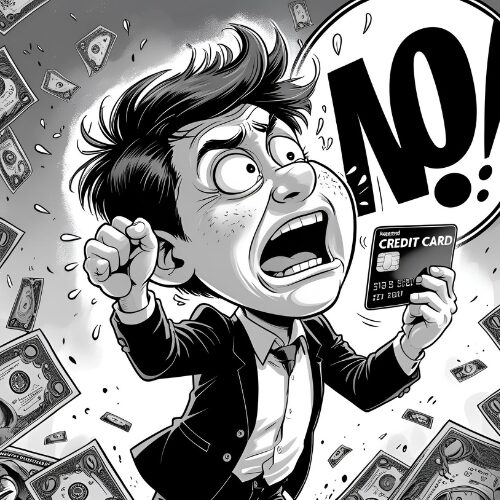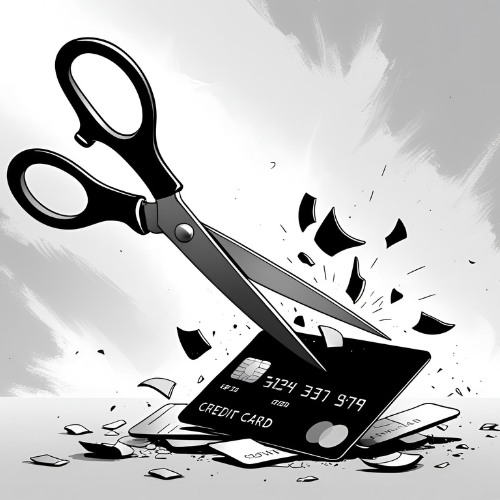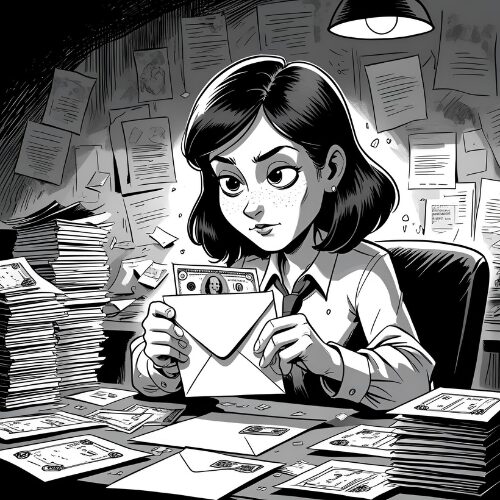(I bet it’s not the B-word you think it is)

The B-Word (She’s a G.D.B.)
Things have not gone well this year, and I am considering bankruptcy.
That’s BANKRUPTCY.
How did I end up here?
To keep it short and to ignore all the little compounding factors:
- I bought a house in 2023 that needed repairs, so I took on several projects.
- I left my full-time job in December of 2024, for reasons that I still think are valid, though of course I have been experiencing plenty of doubt about that.
- I have not yet replaced the income from that job.
- I had a baby in March of 2025.
When I look at the list of bills which haven’t been paid in months, and which include the mortgage, car payments, car insurance and more, I don’t see a way out.
I’m considering bankruptcy with the thinking that perhaps it would be a way to control the fall.
But bankruptcy is considered a bad word, and the mention of it can be conversation-ending.
Most people don’t know that much about it, however.
There are obviously negative moral connotations to the word, and I think the general view is that a person who files bankruptcy is irresponsible or just trying to make others pay for his or her mistakes.
Man, It’s Expensive to Be Alive
I’m not going to explore the moral correctness of bankruptcy too much in this post, but I do want to talk about some basic living expenses.
Housing costs start at about $1,200.00 where I live, and that’s typically for a studio or one-bedroom apartment.
That amounts to $14,400.00 per year.
Let’s keep going with some bare minimum costs:
Housing: $1,200.00 / month minimum
Car insurance: $100.00 / month minimum
Utilities: $150.00 / month minimum
Gas: $120.00 / month minimum
Health insurance: $300.00 / month minimum
Dental insurance: $15.00 / month minimum
Vision insurance: $6.00 / month minimum
Groceries: $400.00 / month minimum
Life insurance: $20.00 / month minimum
Household needs
(toilet paper, soap, laundry detergent, etc.): $20.00 / month minimum
Clothing and shoes: $20.00 / month minimum
Out-of-pocket medical and dental costs: $200.00 / month minimum
Personal care items
(shampoo, toothpaste, deodorant, etc.): $5.00 / month minimum
Cell phone: $50.00 / month minimum
Car payments / repairs / maintenance: $150.00 / month minimum
Total: $2,706.00 / month and $32,472.00 / year
I don’t think I’ve made more than $60,000.00 in a year yet, and I only hovered around that for the last two or three years before I left my job in December 2024.
Prior to that job, my gross (before taxes and deductions) max was around $42,000.00 in a year, and most years much less.
Nonetheless, assuming a gross yearly income of $60,000.00, my after tax amount was probably about $46,000.00 maximum.
$46,000.00 minus the $32,472.00 listed above leaves approximately $13,528.00, or about $1,127.33 per month.
The Financial Reality
Depending on your circumstances, you might be thinking damn! That’s plenty to have left over!
Not so fast.
First of all, the costs I listed above are the absolute minimum I have seen. The reality of most of those costs is much higher.
For example, take the $200.00 per month out-of-pocket medical and dental cost. That number is likely higher by at least $50-$100 monthly, if not more. Dental crowns or fillings cost at least a few hundred after insurance, and usually there is a $50 – $100 deductible payable at your first dental cleaning each year.
I’ve never had less than a $2,500.00 out-of-pocket deductible for health insurance, and usually it’s higher than that.
Prescriptions typically run me $30.00 out-of-pocket for a 30-day supply of one prescription. I have three regular prescriptions.
Plus $400.00 per month for groceries? That’s $100.00 per week, folks. I don’t know if you’ve noticed, but that actually doesn’t go all that far at the grocery store, especially these days.
That clothing and shoe allotment I included totals $240.00 per year. The only way you could make that work in a professional job is likely by shopping exclusively at Wal-Mart and Goodwill (and good luck with the office mean girls).
The personal care budget of $5.00 per month means only $60.00 per year. It’s usually much higher, especially for women, even for *frugal* women.
And now I have a baby. Her daycare costs $305.00 per week. Her formula costs approximately $30.00 per week. She had a prescription for two months that cost $30.00 each month.
And then there are the consumer debt payments, of which I now have many, including student loan debt.
And, even if you never go on vacations (I can’t remember what a vacation feels like), most people do like to occasionally do something fun.
Eating out at a cheap restaurant is usually $25.00 minimum for two people.
Supplies for grilling out probably run at least $25.00.
How about mini-golf this weekend? $30.00.
Your family or friends want you to drive a few hours to visit? Minimum $30.00 for the gas.
Then there are the miscellaneous yearly fees.
For example, it typically costs a couple hundred to file taxes each year.
Car registration costs a minimum of $120.00 per year.
Glasses cost at least $150.00 after insurance.
My utilities actually run something like $400.00 or more per month.
Maybe you have the bad luck to run into a police officer trying to make his contact quota while you are going a few miles too fast. That’s usually a minimum of $200.00 (fortunately that has not happened to me in probably 10 years now, knock on wood).
Then, let’s get into basic home maintenance.
A furnace tune-up is a couple hundred dollars. The annual inspection, cleaning, and maintenance of a gas fireplace is a few hundred (I think I paid $300.00 the last time I had it done two years ago).
Any plumber or electrician charges at least $100.00 just to diagnose a problem.
My point is that while I commonly castigate myself for ending up in this situation, the truth is this:
During the years of my life when my financial ship was in good shape, I had no life. I was thirty years old with a roommate. I went straight home after work. I turned down most invitations to do anything at all. I didn’t go on dates. I worked second and third jobs.
Have I also made some stupid money moves in my thirty-three years on this earth?
Oh yeah. Plenty.
But look at those numbers above again. Not much room for error.
I can just hear certain people in this country now.
Well, you shouldn’t have had a baby if you couldn’t afford it. (Though sometimes they say you must have a baby because otherwise who will work and pay into Social Security? Or don’t worry, everything will work out if you have a baby?)
You shouldn’t have gotten pets.
No furniture either, unless you are financially sound.
Healthcare is a privilege, not a right.
Hell, you shouldn’t eat if you don’t make enough money to eat! That’s on you!
(But also somehow you must keep spending to keep everybody profiting.)
And even though I do not agree with the kinds of people that say things like the above, I have apparently spent enough time around that mindset to have believed in it, to have parroted it to people at times, and to have been unable to shake the guilt of it all.
But I think I’m ready to finally, finally, say:
Shut.
The.
F-Word.
Up.
I’ve never taken public assistance (I don’t qualify) or used a food pantry (I’m not looking down on anyone who has).
For too many years, I received praise for having a “good work ethic”.
And that isn’t worth anything in this country.
The only things that get a person off the bottom rungs in this country appear to be nepotism, sociopathic behavior, or luck.
And I was too stupid and/or idealistic to work the nepotism angle while I was still young.
But I digress.
Bankruptcy Basics
Let’s get back to the B word.
I’m going to break down some bankruptcy basics below.
(PSA: Bankruptcy is complicated, and I am not a lawyer, so the following is not advice!)
An individual (i.e. not a business) filing bankruptcy would usually consider only two types of bankruptcies (there are others).
Those are Chapter 7 and Chapter 13. According to Debt.org, 98% of bankruptcy filings are either Chapter 7 or Chapter 13.
Chapter 7: Liquidation
Chapter 7 is a liquidation bankruptcy and it does not require a repayment plan.
What does that mean? It means if you own anything of value, get ready to say goodbye.
(Fortunately or unfortunately, most of what the average person owns is not considered valuable).
Essentially, a designated person (the “trustee”) sells any eligible property you own to pay off your debts. By eligible, I mean there are certain kinds of property that are protected from being sold and the rules on that can vary by state.
Any remaining eligible debts after that would be discharged, which means you would not be required to pay them. By eligible, here I mean there are some debts that cannot be discharged (i.e. you will never escape them unless you can pay them). Student loan debt is one of these. Tax debt is another.
According to UScourts.gov, “one of the primary purposes of bankruptcy is to discharge certain debts to give an honest individual debtor a “fresh start.””
As you can guess, this means that one aspect of filing for bankruptcy is proving that you are honest and deserving of a fresh start, and therefore you must provide a lot of personal information.
According to that same source, you must provide the following:
- Bankruptcy petition
- Information (“schedules”) on assets and liabilities
- Information (“schedules”) on current income and expenses
- Statement of financial affairs (I don’t know what this means)
- Schedule of executory contracts and unexpired leases (I don’t know what this means)
- Tax returns for the most recent tax year as well as the tax returns filed during the case
Side note: I hate the word “schedule” used in this context. What a pompous, confusing word. Schedule basically just means a list of information.
If you have consumer debts, there are further requirements.
According to Azcourts.gov, consumer debt includes store credit cards, credit cards, medical bills, auto loans, and student loans.
For consumer debts, you must also provide the following (Source: UScourts.gov):
- A certificate of credit counseling and a copy of any debt repayment plan developed through credit counseling.
- Proof of income earned from a job within the 60 day period prior to filing, if applicable.
- Details of monthly net income, and any expected increase in income or expenses.
- A record of any interest the debtor has in federal or state qualified education or tuition accounts.
Finally, if you are married, there are some additional things to think about. Your spouse doesn’t have to file for bankruptcy with you, but you still have to provide information on your spouse’s income, expenses, assets, and liabilities.
I’m not sure why this is considered a separate list, but UScourts.gov clarifies that as part of the above outlined information, the following must be present:
- A list of all creditors and the amount and nature of their claims. So your bank, Capital One, American Express, your student loan servicer, the hospital where you had your baby, etc.
- The source, amount, and frequency of the debtor’s income.
- A list of all of the debtor’s property.
- A detailed list of the debtor’s monthly living expenses, which would include food, clothing, shelter, utilities, taxes, transportation, medicine.
Just Because You’re Broke Doesn’t Mean Bankruptcy is Free
There are filing fees due to the court in order to submit the petition for bankruptcy (and obviously these go beyond any fees paid to a lawyer). Per UScourts.gov, “the courts must charge a $245 case filing fee, a $75 miscellaneous administrative fee, and a $15 trustee surcharge.”
I assume, but I don’t know, that these are minimum amounts and courts can charge more. Not sure on that.
The Public Flogging…I Mean Creditor’s Meeting
There will be a meeting that you, the debtor, have to attend along with the trustee, and everyone to whom you owe money.
Apparently at this meeting, your creditors get to ask you all kinds of questions about your financial situation and decisions.
After the meeting, the trustee tells the court whether you deserve the bankruptcy. The actual words are, whether the case is “presumed to be abuse.”
The bankruptcy judge is not allowed to attend the meeting.
Who is the Trustee, Anyway?
The court picks a neutral party. This is not somebody in your life, and nor is it a government employee. I assume the court has an approved roster of these people and you just get assigned one.
The trustee is supposed to make sure that you are not committing fraud or otherwise hiding information. As noted above, they attend the creditor’s meeting and then report back to the court. The trustee is also responsible for selling any eligible property to pay off your debts.
Chapter 13: The “Wage-Earner’s” Bankruptcy
The name on this one is kind of hilarious/ridiculous. I’m going to guess that “wage-earners” are filing both Chapter 7 and Chapter 13 bankruptcies. But I suppose what they really mean is “good wage-earners”.
Chapter 13 is for people who can’t pay their debts, but make enough money to pay them under an adjusted plan over 3 to 5 years.
Apparently this is the option for people who own a house and hope to keep that house from foreclosure.
Additionally, according to Uscourts.gov, “Chapter 13 acts like a consolidation loan under which the individual makes the plan payments to a chapter 13 trustee who then distributes payments to creditors. Individuals will have no direct contact with creditors while under chapter 13 protection.”
For Chapter 13, you have to provide the same information as noted above for Chapter 7, and you still have to have the meeting with the creditors and the trustee. The difference is (and I’m obviously oversimplifying this), you have to submit a repayment plan that your creditors agree to, and then you have to stick to that plan.
A successful Chapter 13 case can prevent a foreclosure on your home, or it can stop a foreclosure in progress, but if your bank gets its ducks in a row first and sells the house, the bankruptcy case doesn’t change anything.
How Long Does It Take?
The Chapter 7 bankruptcy process typically takes between 3 to 5 months, according to Debt.org.
A Chapter 13 repayment plan may take 3 to 5 (but not more than 5) years.
Bankruptcy Consequences
It seems the consequences could vary wildly, depending on your specific circumstances, and the level of stigma prevalent in your social circles.
However, concrete consequences include the following:
A Chapter 7 bankruptcy stays on your credit report for 10 years.
A Chapter 13 bankruptcy stays on your credit report for 7 years.
According to Debt.org, your credit score could drop by as much as 240 points.
You may not be able to get loans, and if you do, the interest rate is likely to be much higher.
As for me, my credit is already ruined, and I can’t get loans anymore anyways.
I am worried, though, about being able to rent an apartment if I lose my house. A lot of landlords do credit checks, and so do some jobs.
Decisions, Decisions
The process to file for bankruptcy seems tortuous at best, and of course I don’t actually want to do it.
I want to find other solutions.
However, I’m already attempting to develop side hustles.
I’ve spoken with a non-profit credit counselor as well, and while he offered some great consolidation options, I ran into two issues with moving forward.
First, he was unable to work with several of my lenders because they, by policy, don’t work with third parties. Second, and this is the real barrier, I had zero extra cash to begin making payments.
I think I’m running out of time and time is of the essence.
If I wait too long on the bankruptcy decision, we might find ourselves homeless. Still, a Chapter 13 bankruptcy requires a lawyer, which obviously costs money.
But, I’d have to sell the house first to file a Chapter 7 on my own.
And then where to live?
Well, TBD, fam.









